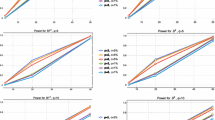Summary
This article develops a rank based inference using a dispersion function for repeated measures incomplete block designs (IBD) with baseline values as covariates. Scores, Waldtype and drop in dispersion tests are developed for testing slope equals zero and equality of treatment effects. Multiple comparison procedures are also developed usingR-estimators which are obtained by minimizing a piece-wise linear dispersion function. A consistent estimator of a scale parameter, which appears in test statistic as a standardizing constant, is discussed. A data set from pharmaceutical research, which compares 12μg and 24μg formoterol (asthma drug) solution aerosol with a placebo treatment, is analyzed using the result of this article.
Similar content being viewed by others
References
Adichie, J. N. (1978). Rank tests of sub-hypotheses in the general linear regression,Annals of Statistics, 6, 1012–1026.
Arnold, S. F. (1981).The Theory of Linear Models and Multivariate Analysis. John Wiley and Sons Inc., New York.
Bloch, D. A. andGastwirth J. S. (1968). On a simple estimate of the reciprocal of the density function.Annals of Mathematical Statistics, 39, 1083–1085.
Hettmansperger, T. P. (1984).Statistical Inference Based on Ranks. John Wiley and Sons, New York. Chapter 5.
Jaeckel, L. A. (1972). Estimating regression co-efficients by minimizing the dispersion of residuals.Annals of Mathematical Statistics, 43, 1449–1459.
Jones, B., andKenward, M. G. (1987). The analysis of data from 2×2 cross-over trials with baseline measurements.Statistics in Medicine, 6, 911–926.
Jureckova, J. (1971). Nonparametric estimate of regression coefficients.Annals of Mathematical Statistics, 42, 1328–1338.
Liang, K.-Y. andZeger, S. L. (1986). Longitudinal data analysis using generalized linear models.Biometrika, 73, 13–22.
McKean, J. W. andHettmansperger, T. P. (1976). Tests of hypotheses based on ranks in the general linear model.Communications in Statistics-Theory and Methods, A5(8), 693–709.
Mehta, C. R. andPatel N. R. (1995). Exact logistic regression: Theory and examples.Statistics and Medicine, 14, 2143.
Mehta, C. R., Patel, N. R., Senchaudhury, P. andTsiatis, A. (1994). Exact permutation tests for group sequential trials.Biometrics, 50, 1042–1053.
Nelder, J. A., andMead, R. (1965). A simple method for function minimization.The Computer Journal, 7, 308–313.
Patel, H. I. (1983). Use of baseline measurements in the two-period cross-over design.Communications in Statistics—Theory and Methods, 2693–2712.
Rashid, M. M. (1995). Analysis of repeated measures incomplete block designs usingR-estimates.Statistics and Probability Letters, 22, 213–221.
Rashid, M. M., andNandram, B. (1995). A rank based analysis of one-way repeated measures designs with a changing covariate.Journal of Statistical Planning and Inference, 46, 249–263.
Rashid, M. M. (1994). A rank based approach to using baseline values in repeated measures incomplete block designs. Technical Report, Department of Mathematical Sciences, Worcester Polytechnic Institute, Worcester, MA 01609.
Rashid, M. M. andBagchi, A. (1997). Robust analysis of one-way repeated measures designs with multiple replications per cell.Statistica Sinica, 7, 647–667.
Senn, S. J. (1989). The use of baseline in clinical trials of brochodilators.Statistics in Medicine, 8, 1339–1350.
Senn, S. andAuclair, P. (1990). The graphical representation of clinica trials with particular reference to measurements overtime.Statistics in Medicine, 9, 1287–1302.
Schafer, W. D. (1981). Letters to the Editor.The American Statistican, 35, 179.
Senn, S. J. (1993).Cross-Over Trials in Clinical Research. John Wiley and Sons, Chichester, England, U.K.
Zeger, S. L. andLiang, K. Y., andAlbert, P. S. (1988). Models for longitudinal data: A generalized estimating equations approach.Biometrics, 44, 1049–1060.
Author information
Authors and Affiliations
Additional information
Part of this work was completed when the author was a faculty member at Worcester Polytechnic Institute. Worcester, Massachusetts. The view expressed in this article are those of the author and not those of the United States. Food and Drug Administration.
Rights and permissions
About this article
Cite this article
Rashid, M.M. On the use ofR-estimators in analyzing repeated measures incomplete block clinical trials with baseline values as covariates. J. It. Statist. Soc. 5, 261–284 (1996). https://doi.org/10.1007/BF02589176
Issue Date:
DOI: https://doi.org/10.1007/BF02589176




